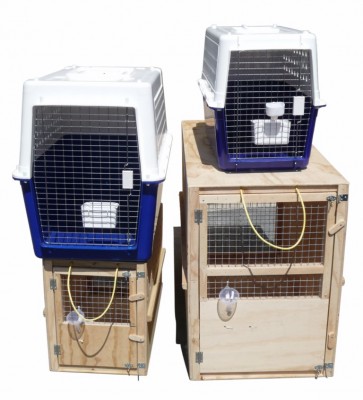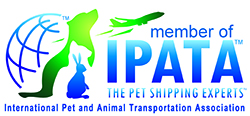
Pet transport cages for rent come in all sizes to suit your pet.
All airlines require IATA approved cages for both domestic and international flights; the main aim of the cage requirements is to ensure that your pet travels in comfort and safety without harming their welfare.
Free Quote Form Phone or Email Us
IATA cage requirements
The cage must allow the animal enough room to move around, this means the animal should be able to stand, sit erect, lie in a natural position and be able to turn around normally. Cages constructed entirely out of wire mesh or welded mesh are not allowed for air travel. The locking pins and door hinge of plastic transport cages must engage the cage at least 1.6 cm beyond the horizontal extrusions below and above the door. At least 16% of the total surface of the 4 sides of the cage must be for ventilation. All of the openings must be paw and nose proof. The cage needs a water container on the inside with a funnel on the outside that can be filled without opening the kennel door.
A maximum of 2 adults of the same species and comparable size with a weight of less than 14 kg each that are used to living together may travel together in a single unseparated container. Up to 3 kittens or puppies less than 6 months of age and coming from the same litter are allowed to travel in the same cage. Females with young and unweaned babies are not allowed to air travel. All pets must be a minimum of 8 weeks of age.
Snub nose dogs require plenty of ventilation due to the respiratory problems caused by the anatomy of the nose.
Wooden cage requirements
The cage must be lumber screwed or bolted together and lined with solid wood or plywood sides. The plywood used must have a minimum thickness of 12mm.The maximum size for the welded mesh openings is 25mm x 25mm. the openings must be nose and paw proof and can be made smaller depending on the animal traveling in the cage. The welded mesh must be attached to the outside of the frame with staples that are at least 20mm long at intervals smaller than 25mm. The thickness of the welded mesh must at least be 12 gauge.
Dog cages need an addition wooden frame over the edges of the wire; the wood should comply with IPPC regulations or manufactures wood grade. The wooden frame needs to be attached with screws, this compresses the wire between the frame and outer surface of the cage. Handles or handling spacer bars must be attached along the middle of both long sides of the cage.
The floor of the cage must be solid and leak proof. The door can either be sliding or hinged and must form the whole of one end of the container. The door must be constructed of cast or welded metal or plastic with a sufficient gauge or thickness to prevent the animal from damaging the door. If mesh is used for the door it must be paw and nose proof to prevent injury to the animal.
Our recommendations
As a general guideline we advise all cages have a minimum of 5cm head clearance, 2 x shoulder width and 15cm extra on length.Cage requirements are only a guideline and some airlines might have additional requirements.
We stock cages for both sale and rental requirements. It is important to note that the rental cages are only available for domestic flights within New Zealand. If you need more information about cages and how to choose the best crate for your pet you are welcome to contact us.
Conclusion
Specified cage requirements are used to protect the welfare of your pet. Airlines will not transport animals in travel containers that do not fit these requirements. Buying or renting a certified travel cage from a Pet Transporter will give you confidence that your cage will meet all of these requirements.

